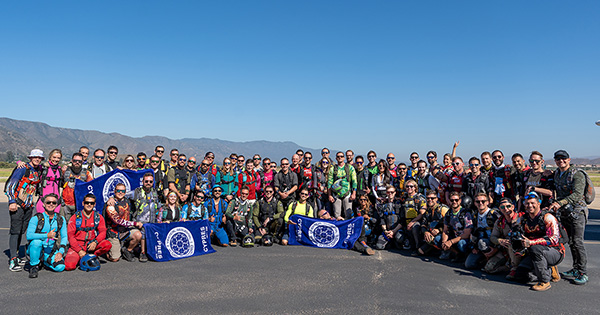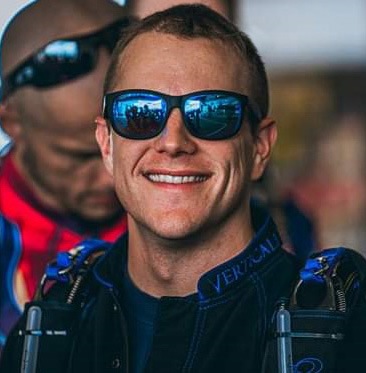Easy as One, Two, Three … Four
Above: Photo by Seth Robison.
In mid-June, 64 skydivers set two head-down sequential world records—for largest three-point and four-point formation—at Skydive Elsinore in California, which are currently pending ratification by the Fédération Aéronautique Internationale. It took the team only 10 jumps over three days to set both records. Punctuating this remarkable achievement was the fourth formation—a new type of formation for a jump of this size—which featured two concentric circles of skydivers. The team built this point with time to spare. Incredibly, the organizers never needed to re-slot any of the jumpers, much less ask them to sit out. All 64 of the jumpers invited to attend were on the jumps from beginning to end.
Making all of this possible were organizers Matt Fry and Andy Malchiodi, who have turned building large, vertical formations into a near science. Their gradual approach to implementing experimental skydives combined with their depth of experience organizing and building large, dynamic formations gave them a solid foundation of new ideas and established practices to draw from. Add to this a roster of very talented skydivers who have regularly attended Fry and Malchiodi’s events. It was a perfect storm of the right flyers in the right slots at the right time, flying perfectly. This combination made such a radical new formation look easy.
These new formation ideas lean heavily on the whacker-line style of build engineering—a style belly-flyers use heavily and vertical flyers have adopted in more recent years—displacing the once-established pod-and-bridge style that vertical flyers used to use primarily. This provided more localized “give” in each formation, which prevented a lot of the motion from traveling throughout the rest of the formation.
This build idea, while not unique to Fry and Malchiodi, has been useful to them as they organized and tooled formations. Malchiodi’s signature Elsinore Echelon events and Fry’s Vertical Formation Workshops have proven very fruitful wells of knowledge.

Photo by Seth Robison.
The event wasn’t without challenges. A solid heat wave was occurring, with temperatures gradually nearing triple-digit Fahrenheit levels over subsequent days. This didn’t help the climb rate of the airplanes—a single Skyvan and two Twin Otters—and resulted in almost hour-long plane rides to the exit altitude of almost 20,000 feet MSL. With the aircraft in the standard echelon pattern, pilot Laurent Lobjoit flew lead, with Frank Frassetto and Joe Marlay flying the left and right trail aircraft.
Aside from setting impressive records, the event also served a second purpose: proving a new way to build the next 200-person head-down world record, an ambitious feat that has proven elusive for almost a decade. Among other attendees, Rook Nelson—organizer of numerous head-down world record attempts, including the current 164-way world record—attended to witness the build firsthand and participate.
Also in attendance as a witness was Fédération Aéronautique Internationale Judge Randy Connell, who complimented the team on the smooth and streamlined build of the formation and how easy Malchiodi and Fry made the complex task of putting together records look. FAI Judge Gorka Amian and National Judge Rhonda Kaletz agreed with Connell that the two world records were complete, and when the three-judge team announced the news, the participants erupted in cheer.
It must have been quite a pivotal moment, especially for Fry, as it marked the reality of the judging rules he helped update years ago that allowed for flying formations such as concentric circles. The two new records also broke the 42-way three- and four-point world records that he organized with Melissa Nelson in 2018, the first world record event he organized. The world of record events has both literally and figuratively come full-circle.
 About The Author
About The Author
Ryan Sass, D-31681, calls Skydive California in Tracy his home drop zone. He’s now earned 13 world records over his 179-consecutive-months skydiving avocation. He enjoys trash, milk steaks and his hobby of magnets.

Point 1. Photo by Nathan Roth.

Point 2. Photo by Nathan Roth.

Point 3. Photo by Nathan Roth.

Point 4. Photo by Nathan Roth.